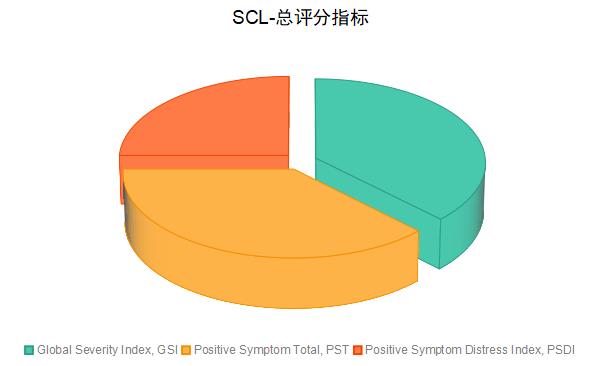
90项精神症状自评量表(SCL-90)
- • 90道精选问题
- • 深度分析
- • 1028人已测
SCL-90包含90个项目,每个项目评估一种症状或情感困扰,采用5点量表(0-4)进行评分,其中:
- 0:没有
- 1:轻度
- 2:中度
- 3:重度
- 4:极重度
量表共包括9个症状维度及3个总评分指标:
9个症状维度

1.躯体化(Somatization):评估个体对身体不适感的体验,如头痛、背痛等。
2.强迫症状(Obsessive-Compulsive):评估强迫思想和行为,如重复检查、过度担忧等。
3.人际关系敏感(Interpersonal Sensitivity):评估对人际关系的敏感和不安感。
4.抑郁(Depression):评估抑郁情绪、缺乏动力和兴趣等症状。
5.焦虑(Anxiety):评估焦虑情绪和生理紧张反应。
6.敌对(Hostility):评估愤怒、敌意和攻击性行为。
7.恐怖(Phobic Anxiety):评估对特定情境或对象的非理性恐惧。
8.偏执(Paranoid Ideation):评估对他人怀有敌意或不信任的观念。
9.精神病性(Psychoticism):评估精神病性症状,如幻觉、妄想等。
3个总评分指标
1.总均分(Global Severity Index, GSI):所有项目的均分,反映总体心理症状的严重程度。
2.阳性项目总数(Positive Symptom Total, PST):评分大于0的项目数目,反映有症状的项目数量。
3.阳性症状均分(Positive Symptom Distress Index, PSDI):所有阳性项目的均分,反映有症状项目的平均严重程度。

优点与局限性
优点:
-全面性:涵盖了多种心理症状和困扰,适用于多种心理问题的评估。
-自评方式:个体自主填写,能更真实反映主观感受。
-标准化:有规范的评分和解释方法,便于在不同个体和群体间进行比较。
局限性:
-主观性:依赖个体自我报告,可能受到个人理解和情绪状态的影响。
-文化差异:不同文化背景下,个体对症状的体验和表达可能不同,需谨慎解读。
-泛化性:虽然量表涵盖了多种症状,但并不能替代专业的诊断评估,需要结合其他工具和临床判断。
Symptom Checklist-90, SCL-90相关论文文献:
1."The SCL-90: An Outpatient Psychiatric Rating Scale - Preliminary Report" by R. L. Derogatis, J. R. Lipman, and L. Covi in Psychopharmacology Bulletin (1973).
2."The SCL-90-R: Administration, Scoring, and Procedures Manual-II" by R. L. Derogatis in Clinical Psychometric Research (1994).
3."Use of the SCL-90 to Assess Psychological Distress in Adolescents: A Review of the Literature" by M. A. Reinecke, D. A. Clark, and C. M. Ryan in Journal of Emotional and Behavioral Disorders (1998).
4."The Validity of the SCL-90 in a Mixed Clinical Population" by R. L. Derogatis and J. R. Lipman in Journal of Clinical Psychology (1979).
5."The SCL-90 and the MMPI: A Step in the Validation of a New Self-Report Scale" by R. L. Derogatis, J. R. Lipman, and L. Covi in British Journal of Psychiatry (1974).
6."Psychometric Properties of the SCL-90-R: A Reexamination of Previous Findings" by R. L. Derogatis, J. R. Lipman, and L. Covi in Journal of Clinical Psychology (1976).
7."The Use of the SCL-90 in the Assessment of Posttraumatic Stress Disorder" by R. L. Derogatis and J. R. Lipman in Journal of Traumatic Stress (1991).
8."The SCL-90 as a Screening Instrument for Anxiety Disorders: A Review of the Literature" by M. A. Reinecke, D. A. Clark, and C. M. Ryan in Journal of Anxiety Disorders (1999).